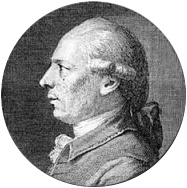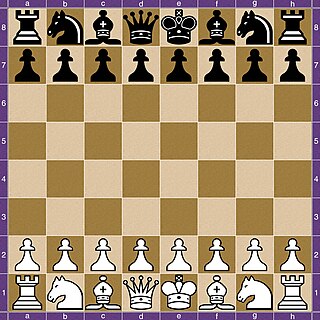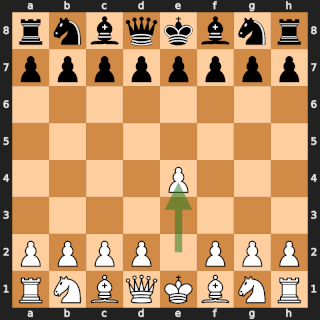The endgame is the final stage of a chess game which occurs after the middlegame. It begins when few pieces are left on the board.
The fifty-move rule in chess states that a player can claim a draw if no capture has been made and no pawn has been moved in the last fifty moves. The purpose of this rule is to prevent a player with no chance of winning from obstinately continuing to play indefinitely or seeking to win by tiring the opponent.
The Lucena position is one of the most famous and important positions in chess endgame theory, where one side has a rook and a pawn and the defender has a rook. Karsten Müller said that it may be the most important position in endgame theory. It is fundamental in the rook and pawn versus rook endgame. If the side with the pawn can reach this type of position, they can forcibly win the game. Most rook and pawn versus rook endgames reach either the Lucena position or the Philidor position if played accurately. The side with the pawn will try to reach the Lucena position to win; the other side will try to reach the Philidor position to draw.
The two knights endgame is a chess endgame with a king and two knights versus a king. In contrast to a king and two bishops, or a bishop and a knight, a king and two knights cannot force checkmate against a lone king. Although there are checkmate positions, a king and two knights cannot force them against proper, relatively easy defense.
Triangulation is a tactic used in chess to put one's opponent in zugzwang. Triangulation is also called losing a tempo or losing a move.

The Philidor position is a chess endgame involving a drawing technique for the defending side in the rook and pawn versus rook endgame. This technique is known as the third-rank defense due to the positioning of the defending rook. It was analyzed by François-André Danican Philidor in 1777. Many rook and pawn versus rook endgames reach either the drawn Philidor position or the winning Lucena position. The defending side should try to reach the Philidor position; the attacking side should try to reach the Lucena position. Said grandmaster Jesús de la Villa, "[The Lucena and Philidor positions] are the most important positions in this type of endgame [...] and in endgame theory."

The Tarrasch rule is a general principle that applies in the majority of chess middlegames and endgames. Siegbert Tarrasch (1862–1934) stated the "rule" that rooks should be placed behind passed pawns – either the player's or the opponent's. The idea behind the guideline is that (1) if a player's rook is behind his passed pawn, the rook protects it as it advances, and (2) if it is behind an opponent's passed pawn, the pawn cannot advance unless it is protected along its way.
The chess endgame with a king and a pawn versus a king is one of the most important and fundamental endgames, other than the basic checkmates. It is an important endgame for chess players to master, since most other endgames have the potential of reducing to this type of endgame via exchanges of pieces. Players need to be able to determine quickly whether a given position is a win or a draw, and to know the technique for playing it. The crux of this endgame is whether or not the pawn can be promoted, so checkmate can be forced.
In chess, the exchange is the material difference of a rook for a minor piece. Having a rook for a minor piece is generally advantageous, since the rook is usually more valuable. A player who has a rook for a minor piece is said to be up the exchange, and the other player is down the exchange. A player who wins a rook for a minor piece is said to have won the exchange, while the other player has lost the exchange. The opposing captures often happen on consecutive moves, but this is not strictly necessary. Although it is generally detrimental to lose the exchange, one may occasionally find reason to purposely do so; the result is an exchange sacrifice.
In chess, a fortress is an endgame drawing technique in which the side behind in material sets up a zone of protection that the opponent cannot penetrate. This might involve keeping the enemy king out of one's position, or a zone the enemy cannot force one out of. An elementary fortress is a theoretically drawn position with reduced material in which a passive defense will maintain the draw.
The rook and pawn versus rook endgame is a fundamentally important, widely studied chess endgame. Precise play is usually required in these positions. With optimal play, some complicated wins require sixty moves to either checkmate, capture the defending rook, or successfully promote the pawn. In some cases, thirty-five moves are required to advance the pawn once.
The chess endgame of a queen versus pawn is usually an easy win for the side with the queen. However, if the pawn has advanced to its seventh rank it has possibilities of reaching a draw, and there are some drawn positions with the pawn on the sixth rank. This endgame arises most often from a race of pawns to promote.
The opposite-colored bishops endgame is a chess endgame in which each side has a single bishop and those bishops operate on opposite-colored squares. Without other pieces besides pawns and the kings, these endings are widely known for their tendency to result in a draw. These are the most difficult endings in which to convert a small material advantage to a win. With additional pieces, the stronger side has more chances to win, but still not as many as when bishops are on the same color.
A pawnless chess endgame is a chess endgame in which only a few pieces remain, and no pawns. The basic checkmates are types of pawnless endgames. Endgames without pawns do not occur very often in practice except for the basic checkmates of king and queen versus king, king and rook versus king, and queen versus rook. Other cases that occur occasionally are (1) a rook and minor piece versus a rook and (2) a rook versus a minor piece, especially if the minor piece is a bishop.
Much literature about chess endgames has been produced in the form of books and magazines. A bibliography of endgame books is below.
The rook and bishop versus rook endgame is a chess endgame where one player has just a king, a rook, and a bishop, and the other player has just a king and a rook. This combination of material is one of the most common pawnless chess endgames. It is generally a theoretical draw, but the rook and bishop have good winning chances in practice because the defense is difficult. Ulf Andersson won the position twice within a year, once against a grandmaster and once against a candidate master; and grandmaster Keith Arkell has won it 27 times out of 27. In positions that have a forced win, up to 59 moves are required. Tony Kosten has seen the endgame many times in master games, with the stronger side almost always winning. Pal Benko called this the "headache ending." David Howell observed, "Especially below elite grandmaster level, this is one of the hardest endgames to draw."

The game of chess is commonly divided into three phases: the opening, middlegame, and endgame. There is a large body of theory regarding how the game should be played in each of these phases, especially the opening and endgame. Those who write about chess theory, who are often also eminent players, are referred to as "theorists" or "theoreticians".
In a chess endgame of a king, bishop, and pawn versus king, a wrong rook pawn is a rook pawn whose promotion square is the opposite color from the bishop's square color. Since a side's rook pawns promote on opposite-colored squares, one of them may be the "wrong rook pawn". This situation is also known as having the wrong-colored bishop or wrong bishop. In many cases, the wrong rook pawn will only draw, when any other pawn would win. This is because the defending side can sometimes get their king to the corner in front of the pawn, after which the attacking side cannot chase the king away to enable promotion. A fairly common defensive tactic is to reach one of these drawn endgames, often through a sacrifice.
In a chess endgame, a wrong bishop is a bishop that would have been better placed on the opposite square color. This most commonly occurs with a bishop and one of its rook pawns, but it also occurs with a rook versus a bishop, a rook and one rook pawn versus a bishop, and possibly with a rook and one bishop pawn versus a bishop.

Kasparov's immortal is a chess game played by Garry Kasparov as White against Veselin Topalov as Black at the Hoogovens Wijk aan Zee Chess Tournament 1999 chess tournament. This is one of Kasparov's most famous games; it is considered a masterpiece and Chess.com has listed it as the No. 1 chess game ever played.





